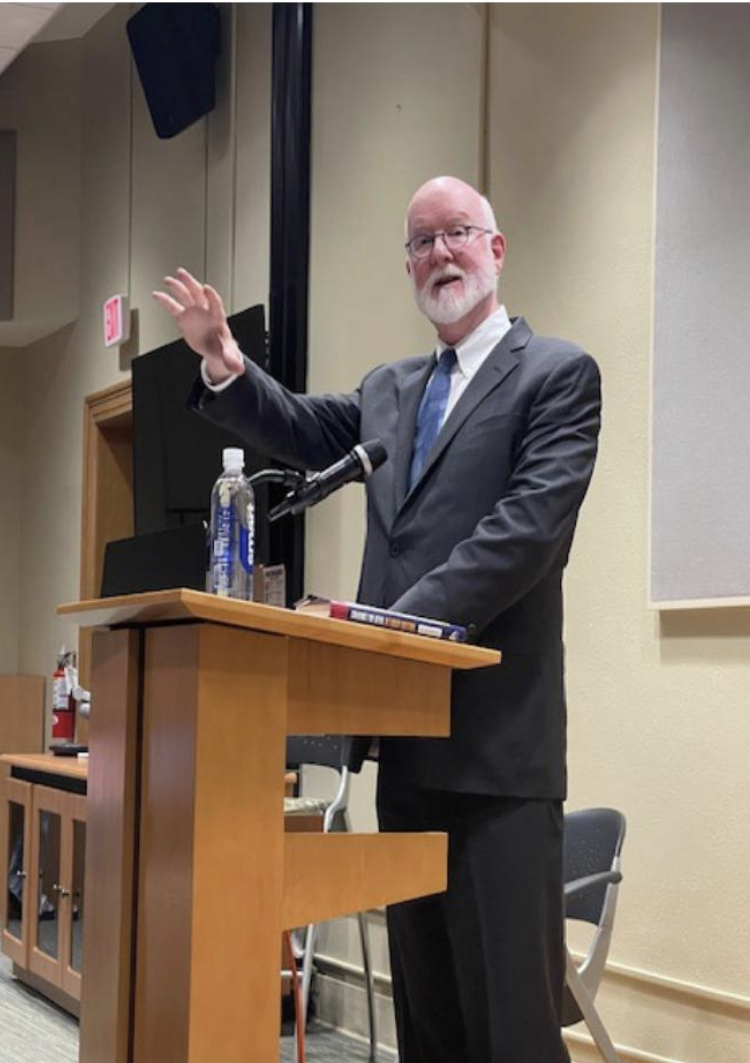Heather Hartel also contributed to this article.
The decision between a woman and her body is an individual one, and while the decision to terminate a pregnancy is difficult, it is critical that this choice be protected for all women, contrary to what a column in last week’s issue of the Old Gold & Black proposed.
Abortion procedures can both protect women from immediate medical risks and ensure that they are able to have children in the future, and the decision to have one remains between individuals and their doctors.
Giving access to abortion recognizes the identities of all of those with uteruses and their personal right to make decisions about their bodies. Yes, men are responsible for half of conception, but they are not responsible for carrying children to term — their bodies do not undergo nine months of physical changes while they are charged with the responsibility of protecting the potential development of life. They do not live with the social pressures around being pregnant or with the decision of whether or not to raise a new human after birth.
Also, men may provide sperm, but because men can’t get pregnant, they are not exposed to the risks associated with pregnancy.
Being equipped with the reproductive organs that allow pregnancy does not guarantee that a pregnancy will be safe or viable. Without access to safe abortions, women who have high-risk pregnancies are forced to continue the pregnancy or seek illegal abortions at the expense of their own health and sometimes lives.
The mortality rate associated with childbirth is 10 times higher than the mortality rate associated with legal abortion care. Every year in the U.S., over 600 women die during pregnancy, over 1,000 women who have live births die from pregnancy-related complications and more than 50,000 women suffer from adverse physiological conditions that result from or are aggravated by pregnancy, according to the CDC.
Additionally, restrictive abortion laws are not associated with lower abortion rates, and barring access to abortion devalues the lives of women who would risk their lives seeking illicit abortions. In the U.S. prior to Roe v. Wade, 200,000 to 1.2 million women had illegal abortions each year, and as many as 5,000 American women died annually as a direct result of abortions performed in medically unsafe environments by individuals lacking medical training and skills.
The death rate from legal abortion, however, is just 0.006 percent according to the World Health Organization. In countries where abortion remains unsafe, it is a leading cause of maternal mortality and accounts for 13 percent of all deaths of women.
Being equipped with the reproductive organs that allow pregnancy does not guarantee the resources to raise a child.
According to the U.S. Census Bureau, of the 12 million single parent families, more than 80 percent were headed by single mothers. If a single mother can work, she will statistically make less than single fathers. Her earning power is less than that of a man, approximately 78 cents for his dollar.
When the wage gap between men’s and women’s average salaries is adjusted for job title, industry, experience, location and several other factors, economists find that women still earn 6.6 percent less than their male counterparts.
For women of color, this disparity is even greater; African American women earn 26 percent less, while Hispanic and Latina women earn 44 percent less.
So yes, pregnancy and the ability to decide on an abortion is inherently a women’s issue.
Employing fear-evoking language when describing an abortion misrepresents the procedure and is a rhetorical tactic that allows pro-birth ideologists to portray women getting abortions as evil murderers. Many abortions are medical abortions, wherein the woman takes abortion pills. In surgical abortions, the kind typically described by those opposing the practice, vacuum aspiration is utilized after the dilation of the woman’s uterus. The brain and skull of a baby are not brutally sucked out of the mother, contrary to what the column stated.
While society dictates that rhetoric surrounding abortion procedures be emotional or shameful, an abortion is simply a medical procedure. Abortion, although demonized, is common, safe and normal.
Abortion is not the greatest evil of our time. Racism, xenophobia, sexism, anti-Semitism, Islamophobia, genocide and systemic oppressions and manifestations of explicit hatred are the greatest evils of our time.
Holding a woman’s personal decision to have a medical procedure within her own body akin to the horrors of slavery or of the Holocaust is ridiculous, inappropriate and fallacious.
To do so is to completely discredit those who suffered. A column that so explicitly and violently demonizes abortion is a direct attack on those who have undergone the procedure or would do so in the future.














Alex Freberg • Nov 4, 2016 at 2:11 pm
So here’s what happened. Intercourse started off as a thing of beauty between a man and a woman to create a child. It has quickly devolved to having intercourse with anyone, anywhere, at anytime. This has obviously created a problem in which unwanted pregnancies are at an insurmountable number every year. I completely understand the argument that “this is how it is in society, women can choose to do this, and it’s their problem if they get pregnant and their choice”, but what it boils down to is a country and a society that has pushed away it’s values year after year and putting wants and impulses in front of logic and morality. Relating this back to abortion now. People no longer value life, it is nothing to us. 99% of abortions (this is a hyperbolous number) are from unwanted pregnancies which are unrelated to medical issues. Some abortions that are clinically necessary should be legal, because it could potentially kill the mother, but women are getting them like it’s a trend. They’ve stopped valuing it for what it was meant to be and see abortion as a cop out after they’ve realized the mistake they’ve made. It boils down to a societal problem, not a woman problem.
Michael McLamb • Nov 3, 2016 at 8:39 pm
On a side note, even though I disagree with the opinions of this article, I want to say that I applaud you for publishing the original article. You obviously strongly disagree with the opinions of the author and received backlash to those that viewed the article to be too controversial. Considering those factors, I think a lot of college newspapers might have gone the censorship route given the same circumstances. But you all didn’t and I immensely respect that.
Michael McLamb • Nov 3, 2016 at 7:56 pm
I do agree with you that abortions should still be allowed in the case of a mother’s life being in danger. In the cases of rape and incest, that’s tough for me. I think we can have that debate, but I’d argue that the life of the child that will be aborted in those cases will be the one that suffers in addition to the mother. And I make that statement being as reverent as I can.
If that were to happen to my future wife or sister or any woman that I cherish, it would be one of the most difficult situations imaginable. But as painful as it would be, I don’t believe the child should suffer for a man’s sin. But again, I think we can have that debate.
However you failed to acknowledge that the aforementioned cases make up a very minuscule percentage of abortions. A recent study in January of this year shows that abortions for the reason of rape accounts for 0.3% of abortions, incest 0.03%, physical life of mother 0.1% and physical health of mother 0.8%. 98.3% of abortions were found to be over cases of convenience i.e. too young, economic reasons, wasn’t ready for life changes and so on. And this study was done by a research organization that is in favor of expanding access to abortions– so no need to ask if its biased or not. If anything the figures they came up with are generous for reasons such as incest, rape and mother’s health. Other studies have shown that number to be even less.
Here’s the link for reference:
http://www.johnstonsarchive.net/policy/abortion/abreasons.html#10
And that brings me to my final point. You failed to address whether or not a human fetus is a life or not. If you can honestly say that you believe that a fetus is not a life then you might have a leg to stand on in this debate. Of course, I’d argue that saying a fetus is not a life is scientifically inaccurate- but still we could actually have that debate. The way you framed the argument though, there really is no debate. If life exists at contraception (which I believe to be scientifically verifiable) then abortion is indeed taking the life of someone who has no say in the matter at all. And as the author made perfectly clear in the original article- that is a moral atrocity.
Hue Janus • Nov 3, 2016 at 5:15 pm
Yea, who cares what the child wants. Let’s just let the parents off the hook for their screwup and keep killing babies.
TONY STARK • Nov 3, 2016 at 5:14 pm
There are many things in this article that i don’t agree with but im just going to list some of the fallacies in your logic when it comes to killing children.
1. You state at the beginning that it is a difficult decision. The reason it is a difficult decision is because deep down we all know that a child is being murdered without even having taken his/her first breath. You can call it, “Abortion,” or, “Termination,” but what it is, is Killing the most innocent among us.
2. You state that it’s, “Her body, Her choice.” Except there is literally another living, growing human being that is inside of her. So it’s not just, “Her body…”
3. You mention that genocide is one of the greatest evil’s of our time so im wondering if the killing of 2700 children a day here in the U.S counts as genocide. Or maybe they’re just all clumps of cells and have no rights even up right until birth, as Hillary Clinton would argue.
4. No one here is demonizing women who get abortions. I know several women who have gotten abortions and there is serious mental trauma that goes with killing your own child. If anything, I feel for these women even more that they felt so hopeless as to kill their own child. That is absolutely heartbreaking, and no woman should ever have to make that decision. What I am advocating is that this option to kill your own child should be taken away. No one should have that right. Of course there are exceptions like Rape, Incest, or the mother’s health. But lets not fool ourselves, it is still Murder, and these cases literally account for less than half of a percent of all abortions in the U.S.
I believe that every person on this earth should have equal rights. I believe that all men, women, and children are created equal with no one having more rights than another. I find it sad and heartbreaking that in some people’s minds, not everyone is equal. Its crazy how in some people’s minds, all life is not equal. And indeed some life is actually more valuable than other life. I don’t hate you, or even dislike you, I just want you to see that all life is valuable and worth something, no matter how small it is. Thanks, and God bless
Hue Janus • Nov 3, 2016 at 5:19 pm
Seeing that you are a male, I didn’t even have to read this to know it’s total garbage.
TONY STARK • Nov 3, 2016 at 5:48 pm
Thank you for your tolerance Hue